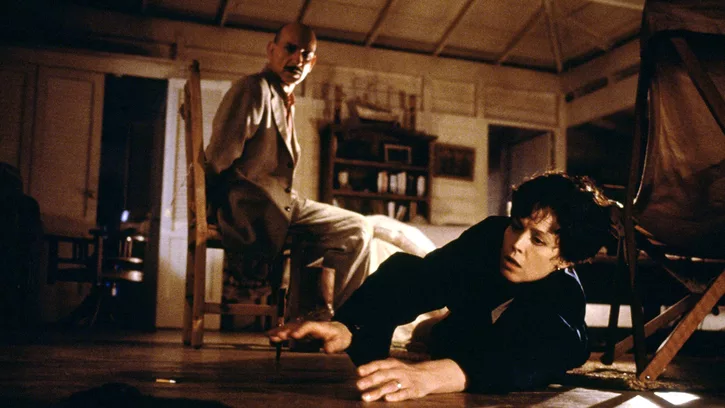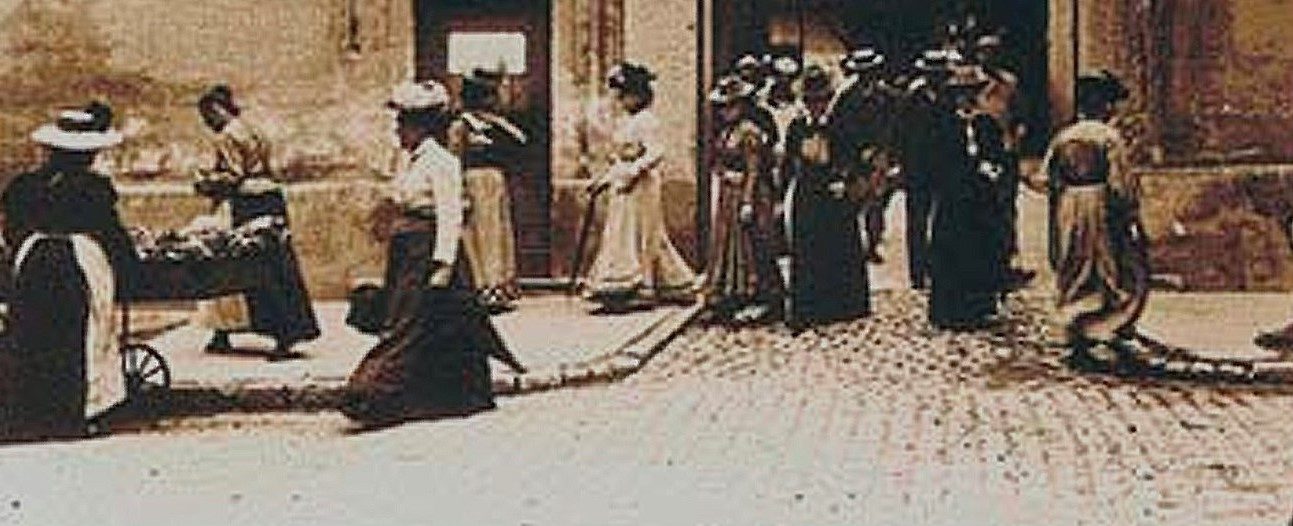France, United Kingdom, 1994
Directed by Roman Polanski
With Sigourney Weaver (Paulina Escobar), Stuart Wilson (Gerardo Escobar), Ben Kingsley (Roberto Miranda)

When does a reign of terror end? News broadcast on the radio report how the new president moves fast to keep his promises, including the creation of an investigative commission on past human rights violations and other stuff. But the woman pacing through an isolated wooden house on the country’s coast does not seem satisfied and secure; she is quite on the opposite, highly-strung, angry, suspicious. When she makes out an unknown car on the horizon, near the lighthouse which is the only trace of human activity in this wild area, she rushed to turn out the lights, shutter openings, pick a gun, hide away. Danger is out there.
What comes is just a husband and a man who carried him after his car’s tire got flat under the driving rain of a storm that has cut off power in the area. But lawyer Gerardo Escobar is not going to get a warm welcome as his wife Paulina blames him for supporting that new investigative commission she deems lacking in scope and reliability. The couple quarrels and it is clear that Paulina did suffer under the previous, dictatorial, military-led regime that ruled this unnamed South American nation and doubts justice and a better future are coming, in stark contrast to her partner.
The man who helped Gerardo rides back to the Escobar house to bring them a spare tire. The lawyer invites Roberto Miranda to have a drink but, hidden in the bedroom, Paulina seems stunned, then grows hysterical, and eventually runs away with clothes, money and above all the guest’s sedan. As the men wonder what is going on, she drives desultorily, then stops the car to examine whatever is in it, and decides to go home.
Terror follows her return. Paulina attacks Roberto Miranda and ties him to a chair before proceeding to his interrogation before the appalled eyes of Gerardo. She claims to have recognize the voice, the scent, and other details of the doctor who helped law officers to interrogate and torture her to get information about the secret opposition movement she belonged to, in particular the name of the leader, who was none other than Gerardo, already a committed lawyer and her lover; the doctor, it turns out, had raped her no less than fourteen times. Paulina has not forgotten and wants a confession, a kind of justice. Her husband is shocked and dismayed by her vengeful attack while her victim claims he is not the guilty one.
As the hours go by, the tension rises. Various places of the house, from the veranda to the toilets, are turned into stages of violent clashes, with the camera smartly exploring the space and navigating around partitions and bodies – the mise en scène does not feel bound by the claustrophobic and theatrical plot to be a static recorder, quite the opposite. This ceaseless confrontation discloses elements of Paulina’s past ordeal and activist life as well as efforts from the men to rationalize what is happening, with Gerardo keen on avoiding the worst and Roberto Miranda trying to save his neck – Paulina is always ambiguous about what she really intends to do with her prisoner. The wider picture that emerges is a heartbreaking and horrifying tale of suffering and lost dignity, with traumatic psychological consequences that cast a fresh light on the behaviors and miens of Paulina in the first sections of the film (till she returns at the house to take on Roberto Miranda). Even Gerardo learns things he has not ever been aware of.
As her mad effort to get the truth out of Roberto Miranda takes an increasingly perverse, dangerous turn, Paulina’s relentless drive raises deeply disquieting but truly important questions: how far can a victim go to get redress? What about the fairness that Paulina claimed was lacking in the grand project of an investigative commission and what about the better future her couple does deserve if she does commit a crime and make Gerardo an accomplice? Is it not possible for a victim to get over pain and let history bury terror? And most importantly, what if she is making a mistake and this Roberto Miranda was really away from the country at the time of her imprisonment? These questions keep nagging the male characters and the audience as her never-ending maneuverings and attacks make the whole situation more and more suffocating and sordid – here, the strength of the edgy and poignant performance of actress Sigourney Weaver cannot be understated (but actors Ben Kingsley, especially given the physical and moral constraints of his part, and Stuart Wilson co a real great, riveting job). Even the idle attempt by Roberto Miranda to take control of situation and of the gun fails to alter the drama; it just hastens it to the edge of the precipice.
The clash ends on the brink of a cliff without any ambiguity, unlike the play the film adapts, thanks to a genuine confession. By then dawn has raised and it is under the clear light of skies after the storm, in the wide open, that come the most terrifying and dismaying revelations about torture, its perpetrators, its victims, and the whole mindset standing behind that perverts a people and its land. Once everything has been said, Paulina can quietly, very quietly, leave the stage, her demand satisfied. The story is over.
Or is it? The narrative is bookended by a stage performance of Franz Schubert’s quartet “Death and the Maiden” which has played such an important role in Paulina’s tragedy. The titles roll over the musicians who pick up at the end their playing; then the camera pans away from the stage to focus on the audience; it appears that both Paulina and Gerardo attend the show, the wife clasping the hand of the husband. Then Paulina looks up and the camera follows the direction of her gaze and finds Roberto Miranda in a box, also attending the concert with his family. He notices Paulina’s gaze and looks back but the camera’s move shows that it is Gerardo he is looking at and who is observing him back before training again his eyes on the stage, just like his wife. Slightly graying hair on Miranda’s mustache and Gerardo’s haircut point to the passing of time; so the whole story could well have been a flashback and the film firmly anchored in present time; and the exchanges of gazes widen the perspective in the most troubling manner.
A reign of terror can be politically put to an end; the victims of terror can find truth and relief; but the memory of terror may be harder to cope with. These three people are bound by a dreadful confrontation that cannot be easily forgotten and the difficulty now may be, indeed, to keep looking at each other and at themselves knowing what happened both in the recent and in the distant past. It could be that terror can still reverberate through life. This is a most ambiguous and disturbing conclusion.

